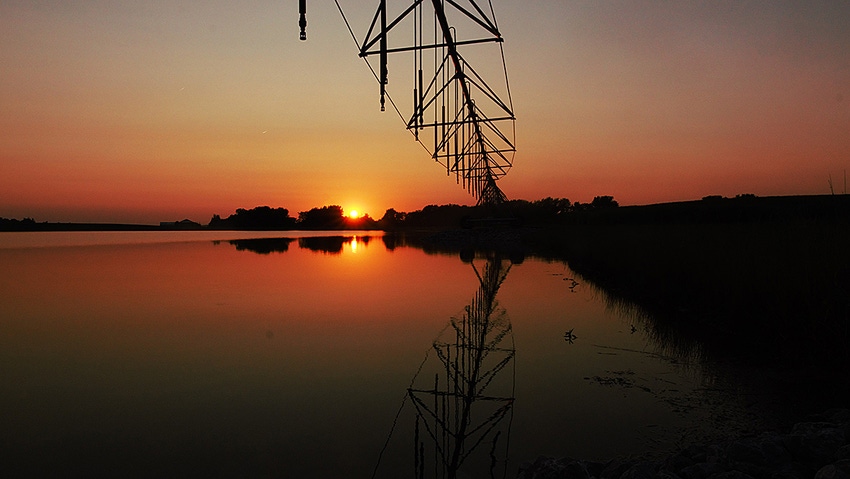November 19, 2015

Like many crop producers east of the Missouri River, Jim Sladek is a firm believer in pattern drainage. Unlike most of his counterparts, he is equally enthusiastic about irrigation. With the installation of an 18-acre pond in mid-December 2014, the eastern Iowa grower married the two passions. By April 1, the pond was full, ready and waiting for use by center pivots. Ninety-five percent of its water came from drain tile.
"It's a closed-loop system, protecting the soil and keeping it and nutrients on the farm," says Sladek, JCS Family Farms.
While Sladek takes environmental concerns seriously, that's not what gets him excited about his new pond and the five center pivots that can feed from it. "My irrigation contractor, Steve Sutter with Landmark Irrigation, told me that the value of the water in a 10-foot deep, 10-acre pond could average $50,000 per year," says Sladek. "That's a net return of $5000 per acre.
Quick payoff
Half the pond sits on never-cropped, peat bog, slough type land.
"Even the cropland I gave up would normally only net a fraction of that per acre. I'm massively ahead using these acres to store water," says Sladek.
He knows irrigation pays in a drought year. When he installed two center pivots in 2012, irrigated acres out-yielded non-irrigated by 120 bushels per acre. Add a premium for the white corn JCS produces and the systems paid for themselves in one year.
While those center pivots were supplied by wells, surface water seemed a better option on 475 acres where he planned to install five center pivots prior to the 2015 season. On the advice of Bruce Barnhart, his earthmoving contractor, he turned to Tom Buman, Agren. Buman used the company's PondBuilder program to evaluate the property, verify it would work and provide needed information for construction...all while Buman and Sladek sat in their respective offices.
In half an hour's time, PondBuilder estimated the height of the dam and surface area of the pond needed to hold 100 acre-feet of water for use in the center pivots. While he still needed an engineering firm to create a Department of Natural Resources approvable plan, the fast analysis allowed him to get the pond built and make the investment in center pivots, all before the end of the year - not a likely scenario had he gone through his Natural Resources Conservation Service (NRCS). In fact, he estimates the traditional process would have delayed everything a year or more.
Having spent 14 years with the NRCS, Buman is quick to defend the quality of work done there. However, he notes that budget cuts have created a need for private sector services such as PondBuilder, now offered by United Suppliers through retail customers.
While some would suggest irrigation is far from a pressing issue in Iowa, Sladek would argue differently. While he only made two passes with the center pivots in 2015, he credits irrigation and available water for a willingness to set higher yield goals and invest in the inputs needed to meet and protect them.
Bonus bushels, water
"We were able to do very aggressive marketing, knowing we had irrigation to fall back on," says Sladek. "It prevents low yields in a bad year and pushes high yields higher in a good year. This year I harvested whole-field averages of 240-260 bushels per acre. I've never gone over 220 in the past on a whole-field average."
Research support for Sladek's practices may be coming. A team of land grant university researchers in Indiana, Iowa, North Dakota, Ohio, Missouri, North Carolina, South Dakota and Minnesota have partnered in a $5 million study of drainage water management, saturated buffers and reservoirs such as Sladek is using.
Jane Frankenberger, professor, Agricultural and Biological Engineering, Purdue University, and project team leader, cites climate change and resulting rainfall variability as one reason for the research. Another is resource and risk management.
Store drainage water
"Drainage water is a great resource in the spring, but producers don't think of it that way, focusing instead on how to get rid of it," she says. "Yet, at the right time, a few inches of water can make a difference."
Sladek agrees. He estimates an average yield bump of 50 bushels per acre per year over a 10-year period. A member of FamilyFarms Group, Sladek has long wondered at farm friends in arid areas who bested his yields year in and year out with irrigation.
"In the Midwest, we are almost arrogant about having the best soils and best rainfall," says Sladek. "We think we don't need irrigation, but these guys are kicking our butts. What could our yield goals be on our highly productive soils if we eliminated water and nutrient limitations?"
About the Author(s)
You May Also Like




